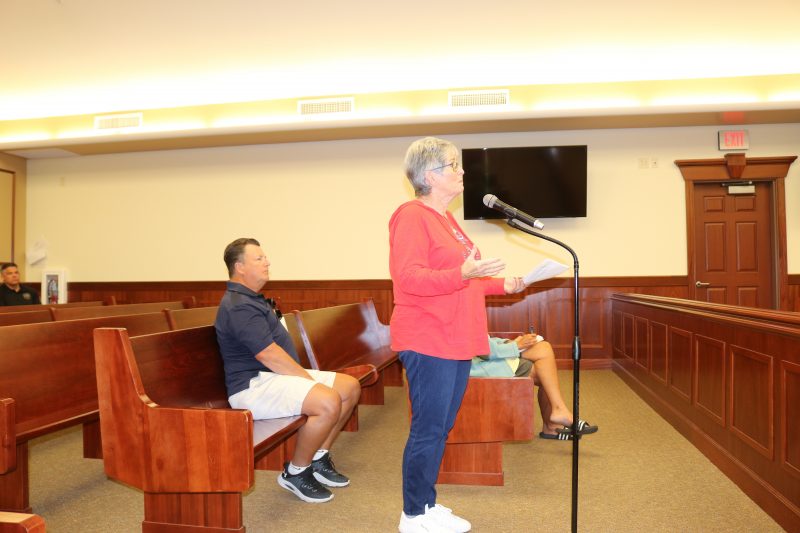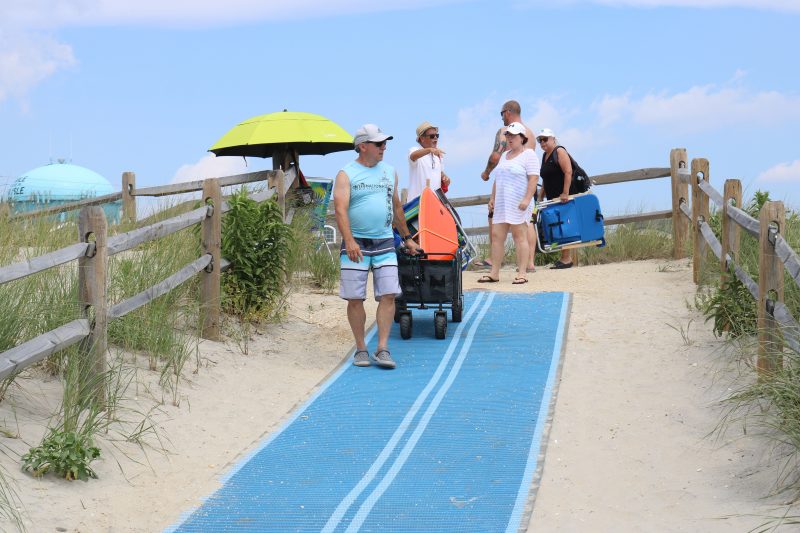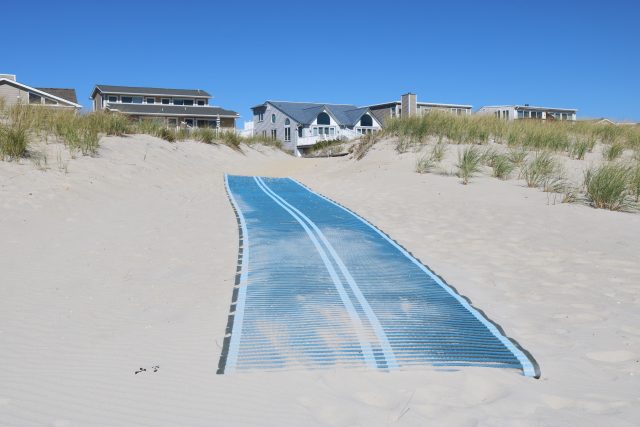By DONALD WITTKOWSKI
For Beth Shubert, the trip to the beach is exactly that – a trip.
Her walk to the beach at 66th Street involves taking a long, ascending pathway over the dunes while trudging through deep sand.
She called the pathway “a back-and-forth mess” because it curves to the right and then to the left before straightening out for the final few steps to the beach.
Shubert appeared at a City Council meeting Tuesday to urge Sea Isle City officials to install more of the popular mobility mats that make it easier for senior citizens and people with disabilities to walk over the sand at the pathways to the beach.
Mayor Leonard Desiderio assured Shubert and other members of the public that the city intends to buy more of the beach mats for next summer. He also said the city plans to hire more seasonal employees to maintain the mats to prevent them from getting covered with slippery, wind-blown sand.
“Quite frankly, the challenge is the availability of seasonal labor. The acquisition of beach access materials is simply a matter of funding – and we have consistently allocated the required funds and obtained the necessary materials,” Desiderio said of the city’s purchase of beach mats for the summer season.
“Getting and retaining seasonal employees has been increasingly difficult over the past several years,” he continued. “Despite this, we will overcome this challenge. This administration is committed to ensuring that access to our most treasured natural resource is available to all members of our community.”
In an interview after the Council meeting, Desiderio stressed that buying more mats – and longer ones as well – is a key part of the city’s strategy to “make the beaches as accessible as we can.”
“That will be a priority for next summer,” he said. “We want to enhance the ways for everyone to get on the beach.”
Earlier this year, City Council approved a $36,798 contract with a private vendor to buy 20 new beach mats. Sea Isle has placed mats at beach entrances the entire length of the island, yet residents routinely appear before Council to urge the city to buy even more.
In public comments Tuesday, Shubert and another Sea Isle resident, Jim Marino, appealed to Council and the mayor to not only buy more of the beach mats, but to also make sure they don’t get covered with sand.
“We all love Sea Isle and the beach, but this is crazy when we can’t get there,” Shubert said.

Marino, who lives at 76th Street and Central Avenue, said he has seen as much as two feet of sand covering the beach mats. He wants the city to have a better maintenance program for the mats – something that Desiderio is vowing Sea Isle will do with the hiring of more seasonal employees next summer.
Shubert, 71, who lives on 66th Street, said it is becoming increasingly difficult for her to walk to the beach. She noted that many senior citizens on the same block have simply given up going to the beach because of the trouble they have walking through deep sand.
“Some have sprained their ankles. One elderly gentleman was using walking sticks and almost fell,” she said in a statement. “Seniors are sitting on the path because they can’t get down to the beach after fighting through the thick sand on the path.”
She noted that 66th Street is not the only beach pathway that is a challenge to navigate.
“When the sand is five inches thick, it makes getting to the beach an ordeal instead of the joy it should be,” she said while calling on the city to buy more mobility mats.
The plastic mats lie on top of the sand, providing an easier transition from the gravel pathways over the dunes to the beaches. They are sometimes referred to as “Mobi- Mats,” short for mobility mats.
Seniors, small children, people with disabilities and families lugging strollers to the beach are all helped by the mats.
The non-slip mats look like bright blue carpet strips from a distance. They don’t extend the entire width across the sand, but make it easier to cross the dunes and head out onto the beach. At the handicap-accessible beaches, the mats average about 70 feet long, city officials say.
Sea Isle has had the beach mats for about 15 years. At first, they were placed at the city’s six handicap-accessible beaches at 32nd Street, 40th Street, John F. Kennedy Boulevard, 44th Street, 63rd Street and 85th Street.
During the summer of 2018, the mats were installed at intervals of about every three blocks between 29th and 91st streets.
As the mats became even more popular with the public, Sea Isle announced plans in 2019 to put them at every one of the lifeguard-protected beaches.
The city then set the goal of having the mats at every beach block between 29th and 92nd streets. Now, the city says it has installed the mats at beach entrances along the entire length of the island – from First Street to 93rd Street.

Shubert, Marino and other beachgoers, though, want to see the city buy even more of the mats and to keep them clear of sand.
“I know this is a hard issue, but I know it can be improved. The blue mats are not working due to the high winds pulling all of the sand from the dunes and covering the blue mats,” Shubert said.
Sea Isle has had two major beach replenishment projects in the last seven years and is scheduled for another one in 2023. Although the projects create wider and prettier beaches, they also have the unintended consequence of making it more difficult for sunbathers to walk through the thick, powdery sand.
Desiderio said the city will find more ways to improve beach access, despite the challenges posed by wider beaches.
“A good thing that has occurred over the past decade is the strengthening of our shore protection. That’s also meant larger beaches on most of the island. We’ve done a lot of work to make the pathways over our dunes easier, but we must do more,” he said.








